
Scaevola is a genus of flowering plants in the Goodenia family, Goodeniaceae. It consists of more than 130 species, with the center of diversity being Australia and Polynesia. There are around 80 species in Australia, occurring throughout the continent, in a variety of habitats. Diversity is highest in the South West, where around 40 species are endemic.

Calandrinia is a genus of flowering plants known as purslanes and redmaids. It includes 37 species of annual and perennial herbs which bear colorful flowers in shades of red to purple and white. Species of this genus are native to the Americas, including western and southern South America, Central America, and western North America. Some species have been introduced to parts of Australia, New Zealand, southern Africa, Asia, and Europe. Over 60 species native to Australia and New Guinea that were formerly included in Calandrinia are now placed in a separate genus, Rumicastrum or Parakeelya. A single eastern Australian species named in 2022, Calandrinia petrophila, is still included in Calandrinia, but will be placed into the Australian genus when the name of the new genus is finally settled.
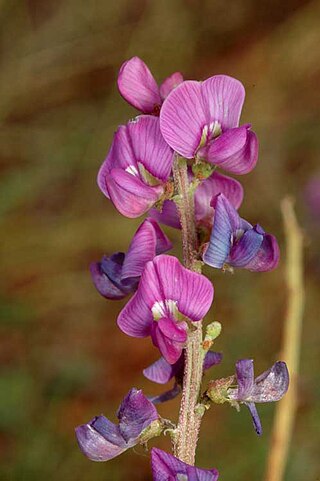
Swainsona is a genus of about 85 species of flowering plants in the family Fabaceae, and is endemic to Australia. Plants in this genus are herbs or subshrubs with imparipinnate leaves and usually purple flowers similar to others in the family.

Mirbelia is a plant genus belonging to the family Fabaceae and is endemic to Australia, occurring in every mainland state except South Australia. Plants in the genus Mirbelia are prickly, perennial shrubs with simple, sometimes sharply-pointed leaves, or the leaves absent. The flowers are arranged singly or in groups in leaf axils or on the ends of branches, the sepals joined at the base with five teeth. The petals are usually red, orange, purplish or bluish and the fruit is an inflated pod.

Xanthosia is a genus of flowering plants in the family Apiaceae and is endemic to Australia. It comprises 20 species of shrubs endemic to Australia. Plants in the genus Xanthosia are perennial herbs or small shrubs, the leaves divided, toothed or lobed,, the flowers white, pinkish or pale green and usually arranged in a compound umbel.
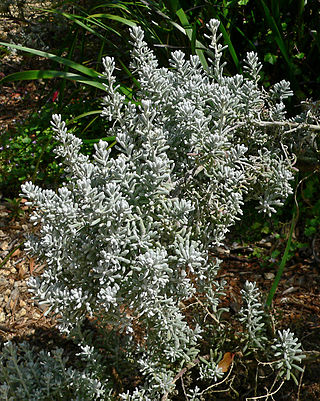
Maireana is a genus of around 57 species of perennial shrubs and herbs in the family Amaranthaceae which are endemic to Australia. Species in this genus were formerly classified within the genus Kochia. The genus was described in 1840 by the botanist, Moquin-Tandon and named to honour Joseph François Maire (1780-1867), an amateur botanist who befriended him during the author's first visit to Paris in 1834.

Trachymene is a genus of herbaceous plants in the family Araliaceae. The species are native to Australia, Malesia, New Caledonia and Fiji.

Calytrix is a genus of about 83 species of flowering plants, commonly known as star flowers, in the family Myrtaceae and is endemic to Australia. Plants in the genus Calytrix are small to large shrubs with small, spreading and more or less round leaves, the flowers arranged singly in leaf axils. The flowers are bisexual with 5 overlapping sepals with a long awn, and many stamens.
Chthonocephalus is a genus of annual herbs in the family Asteraceae. The genus is endemic to Australia, with species occurring in all mainland states.
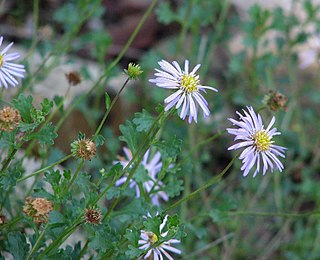
Calotis is a genus of herbs or small shrubs in the daisy family Asteraceae. Most of the species are native to Australia, while two occur in Asia.
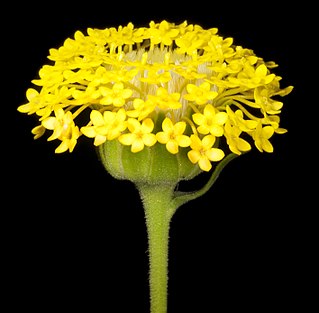
Podotheca is a genus of flowering plants in the tribe Gnaphalieae within the family Asteraceae. All species are endemic to Western Australia, except for Podotheca angustifolia which occurs across the south of Australia.

Rutidosis is a genus of Australian annual and perennial herbs in the tribe Gnaphalieae within the family Asteraceae.

Vittadinia is a genus of Australian and New Zealand plants in the tribe Astereae within the family Asteraceae.
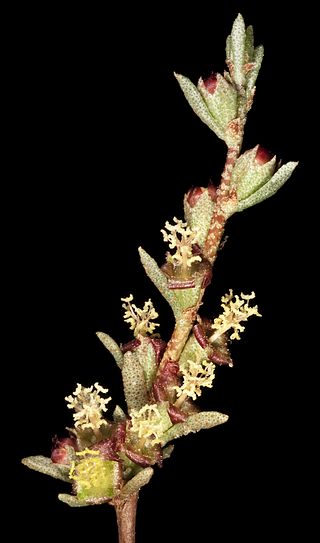
Lawrencia is a plant genus in the family Malvaceae. The genus is endemic to Australia.

Opercularia is a genus of perennial and subshrub flowering plants in the family Rubiaceae. There are about 15 species, all of which are endemic to Australia. Many of the species have an unpleasant odour.
Millotia is a genus of small annual herbs in the tribe Gnaphalieae within the family Asteraceae.

Myriocephalus is a genus of Australian flowering plants in the family Asteraceae.
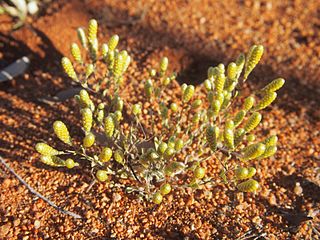
Angianthus is a genus of flowering plants in the family Asteraceae. All species of this genus are endemic to Australia.
















